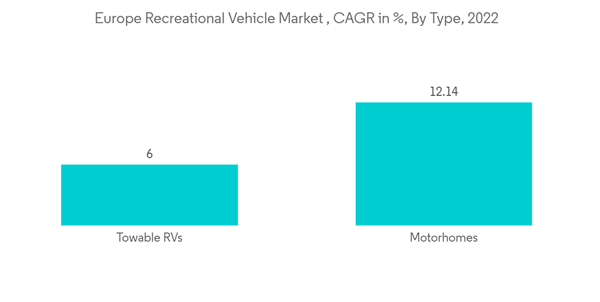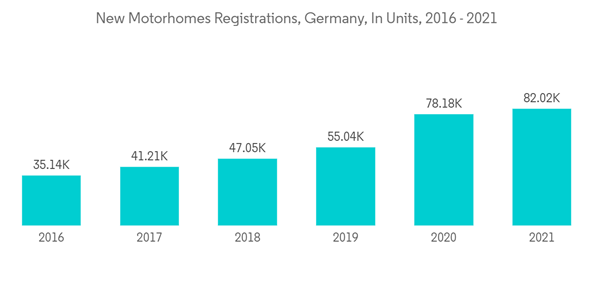Key Highlights
- Due to COVID-19 and the economic crisis, the market registered a decline that year. Recreational vehicle shipments increased in Europe mainly due to travel restrictions imposed on account of COVID-19, as it restricted travelers from international travel due to the lockdown. However, after the ease of lockdowns, travelers actively started opting for recreational vehicle-related activities, which continued till the end of the year and provided recovery to the market studied. Thus, many players are coming up with new products in the market. For instance, in July 2022, German electric quadricycle maker ElectricBrandshas recently came up and showcased its new camper version of XBusto to the public for the first time at the JubilaumsExpo held in Vienna. Although this was not an official launch, this has made the public much interested in the company's official launch in the RV segment.
- Over the long term, with the increase in per capita income, the number of high-net-worth individuals (HNWI) in Europe is also witnessing continuous growth. Last year, Europe accounted for about one-fifth of the total number of HNWIs worldwide. Countries such as the United Kingdom, Germany, Sweden, France, Switzerland, Spain, and Italy accounted for most HNWIs across Europe. Companies in Europe are also focusing on developing new technology to meet the demands of the customers. For instance,
- In May 2022, REE Automotive Ltd. announced plans to install cloud-based robotic assembly lines at its network of highly digitalized global manufacturing plants, beginning with its European Integration Center in Coventry, UK. The first assembly line is scheduled to open in the second half of this year. It will initially focus on the P7 electric platform for commercial vehicles such as walk-in delivery vans, buses, and recreational vehicles to meet European customer demand.
- Moreover, in Europe, the number of millennials is increasing. Last year, the region accounted for one-fifth of the total number of millennials worldwide, which is anticipated to increase during the forecast period.
- However, the high cost associated with the recreational vehicle may hinder the growth of the target market during the forecast period.
Europe Recreational Vehicle (RV) Market Trends
Recreational Vehicles Across the Europe to Gain Significant Prominence During Forecast Period.
- The market is driven by rising per capita income and increased interest in leisure and recreational activities. Recreational vehicles (RVs) have long been linked with camping, which has recently experienced a surge due to an increase in millennial tourists. Various campsites are accessible around the area, with a strong influx of tourists. For instance, in 2021, there were about 30,809 recreational vehicles in France. On average, a motorhome in France will be used 17 times for about 75 nights a year. When renting, the average weekly mileage is about 1,400 km. By the end of 2019, there were 505,000 camping cars registered in France out of an estimated 2 million in Europe.
- Towable RVs will continue to dominate the market until the next few years. The lower prices of these vehicles compared to motorized recreational vehicles have contributed to their growing popularity. Towable vehicles allow customers to pull the trailer with a truck or an existing panel, lowering the price of these vehicles.
- Several market participants, including Winnebago, Hymer AG, and Pleasure-Way Industries, focus on new model launches with various amenities to improve the customer experience. Additional features such as stainless steel rock guards, additional window awnings, rear bumper storage, refrigerators, entertainment systems, and a spacious sleeping capacity for any family size are driving up demand for recreational vehicles. Furthermore, the trend of incorporating advanced technologies into recreational vehicles, such as IoT, sensors, and automated control systems, propels the industry forward.
- In recent years, top OEMs and startups have attempted to combine numerous technological improvements into RVs to make them more appealing and interesting as opposed to dull vehicle designs.
Germany is Anticipated to Hold Major Share in the Market
- According to the European Caravan Federation, in the last year, around 78,175 new motor caravans were registered, which was 44% more than the previous year.
- RVing has become more popular in Germany in recent years than it has ever been. This is reinforced by significant growth in the market for new and used recreational vehicles (motorhomes, camper vans, and caravans) and a significant increase in RV rentals. Therefore, companies are also focusing on strategic partnerships and developing new products. For instance, in January 2022, Ford-Werke GmbH and Erwin Hymer Group (EHG) signed a framework agreement to deliver Ford Transit and Ford Transit Custom as the foundation for customer-ready recreational vehicles and motorhomes.
- The market is being driven by rising per capita income and increased interest in leisure and recreational activities. Recreational vehicles (RVs) have long been linked with camping, which has recently experienced a surge due to an increase in the number of millennial tourists. A variety of campsites are accessible around the area, which sees a strong influx of tourists. OEM is investing heavily to elevate the demand for recreational vehicles among the public. For instance,
- In January 2023, Volkswagen confirmed that a factory camper option for the newly released ID Buzz would be available, though not for a few years. Until it does, other small specialized companies, such as Bavaria-based Alpin Camper, which recently unveiled its Buzz camper at a major tourism and leisure consumer show in Germany, will offer their version.
- The demographics of German RV consumers have shifted. Previously, most of this low-cost vacationing was done by families with children and seniors. RV trips are becoming increasingly popular among younger generations with greater income levels. Customers demand freedom, independence, flexibility, comfort, convenience, individualism, and even luxury.
- At the same time, campsites across Europe are fast developing. Campgrounds have been updated and offer various new amenities and features. The services supplied range from updated laundry facilities, Wi-Fi connections, and supermarkets to wellness centers, pools, and spas, as well as access to water parks, go-kart tracks, and other sporting facilities. Campground vacations resemble a full-service, activity-filled family holiday, competing with resort-style accommodations. Camping has evolved into a luxury holiday, and the idea of the low-cost family trip is disappearing. The transition from conventional tents to pricey campers and RVs is a visible indicator.
Europe Recreational Vehicle (RV) Industry Overview
The European recreational vehicle market is fragmented due to many local and global players, such as Thor Industries Inc., Swift Group, and Hymer AG. The market is transforming at a rapid pace, and local companies are facing tough companies from US RV manufacturers, such as Forest River Inc., Winnebago Industries Inc., and Thor Industries Inc. As a result, companies are incorporating the latest technologies in their latest RV models to provide the best experience to the occupants.In August 2021, Hymer GmbH & Co. KG presented its new products for this year from the Hymer Motor Caravans, Eriba Caravans, and Hymer Original Parts divisions.
Additional Benefits:
- The market estimate (ME) sheet in Excel format
- 3 months of analyst support
This product will be delivered within 2 business days.
Table of Contents
Companies Mentioned (Partial List)
A selection of companies mentioned in this report includes, but is not limited to:
- Dethleffs GmbH & Co. KG
- Thor Industries Inc.
- Swift Group
- Autotrail motorhomes
- Rimor Motorhomes
- Rapido Motorhomes
- Knaus Tabbert GmbH
- Elnagh
- Globecar motorhome
- Eura Mobil GmbH
Methodology

LOADING...










